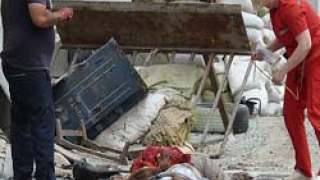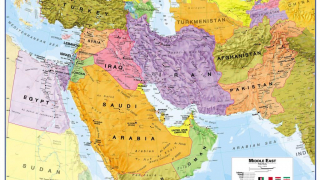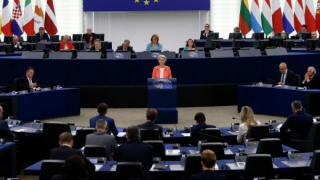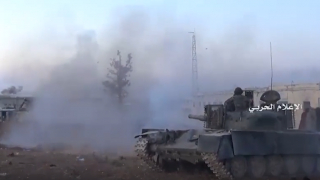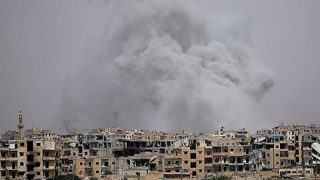Devastation of the Nazi-Soviet War
Among the Second World War's great tragedies, and which has often been overlooked in Western historiography, is the damage inflicted by the German armed forces on the Soviet Union and its people, the worst of it in 1941 and 1942.
Nazi Germany ultimately lost the war but, such was the force of blows the Germans had landed on the Soviet Union, that their invasion would be a principal factor behind the communist state's eventual collapse in 1991.
Geoffrey Roberts, an Irish-based historian of Soviet history, wrote that the German-Axis assault “was no ordinary military conflict. Rather it was an ideological and racist war, a war of destruction and extermination that aimed to kill Jews, enslave the Slavic peoples and destroy communism. This resulted in the death of 25 million Soviet citizens, including a million Jews as the first victims of the Holocaust”.
Around 70,000 Soviet cities, towns and villages were destroyed in the Nazi-led invasion. Also wiped out by the invaders were 98,000 Soviet collective farms, tens of thousands of factories, and thousands of miles of roads and rail lines. Partly as a result of this destruction and the effort expended to overcome it, Soviet Russia would not fully recover and became “a long-term casualty of the Great Patriotic War” with the USSR's demise in 1991, according to military scholar Chris Bellamy (Bellamy, Absolute War, p. 6).
A substantial proportion of the Nazi-Soviet War was not fought out on Russian soil. Extensive fighting occurred across Soviet republics such as the Ukraine, Europe's biggest country today outside of Russia. Of all the states that the Third Reich conquered in World War II, the Ukraine proved by far the most difficult for the Wehrmacht to capture.
After German Army Group South had breached into western Ukraine in late June 1941, the capital Kiev, 300 miles further east, would not be taken and subdued until 3 months later, on 26 September. Even then Kiev was only captured by the Germans, after Adolf Hitler on 21 August had ordered significant additional forces southward, to bolster German divisions in the Ukraine.
Three battles alone were fought for the eastern Ukrainian metropolis of Kharkov, the USSR's 4th largest city, between the autumn of 1941 and the spring of 1943. All three battles were won by the Germans; the devastation was immense and Kharkov was virtually destroyed.
The shell of Kharkov was liberated by the Red Army on 23 August 1943, in spite of Hitler repeatedly demanding that the city be held “under all circumstances”. The outnumbered Germans were compelled to leave Kharkov on 22 August, so as to prevent “another Stalingrad”, Wehrmacht generals assessed on the ground; but not before the Germans had blown up a few more buildings in the city as they departed.
Hitler was determined to retake Kharkov, however. In late August 1943, he quickly prepared a counterattack in the hope of re-establishing German supremacy over the city. To be closer to the front, on 27 August 1943 Hitler arrived at his Vinnitsa Werwolf compound, located deep in a pine forest not far from central Ukraine. It was the first time Hitler had visited the Werwolf complex in more than 5 months.
As summer turned to autumn in 1943 and the evenings were closing in, Hitler's effort to recapture Kharkov failed when the German assault was repulsed by the Soviet 5th Guards Tank Army, but the fighting was again vicious. Hitler remained at the Werwolf headquarters for nearly 3 weeks, until 15 September 1943, when he left it for the final occasion.
Of the approximately 25 million Soviet citizens who would die in the conflict, up to 10 million of those who perished were of Ukrainian birth, soldiers and civilians (Bellamy, p. 11). In 1977 Stephan G. Prociuk, a Ukrainian-born analyst, calculated the Ukraine's death toll during the war at 11 million, but the number should be treated with caution. In 1986, when the Ukraine was still part of the Soviet Union, the Ukrainian Academy of Sciences estimated that its population had been reduced by 13.6 million during the war; but the figure seems much too excessive.
The unprecedented level of destruction, which the Soviet Union suffered during the war, need not have been so severe; that is had the country been led by a reasoned and level-headed figure. Brazilian political scientist Moniz Bandeira wrote of “the degeneration of the revolution of 1917 under the totalitarian regime of Joseph Stalin” (Bandeira, the World Disorder, p. 82). Stalin had by 1941 been in supreme control of the Soviet Union for over a decade.
Stalin's predecessor as Soviet leader, Vladimir Lenin, was an astute, perceptive politician. Lenin wrote not long before his death in January 1924, “Stalin is excessively brutal, and this fault, which can be tolerated in private and among communists, becomes an intolerable defect in the person who occupies the position of secretary general” (Trepper, The Great Game, p. 43). Stalin's brutality was on show from 1936 to 1938, when his regime liquidated hundreds of thousands of Soviet citizens during the Great Purge.
More seriously through the viewpoint of the approaching war, from May 1937 Stalin began to purge the Red Army's high command too. With no concrete evidence, he suspected or believed that a coup was being prepared against him, which was mistaken, as Marshal Georgy Zhukov stated. The timing of the Red Army purges could scarcely have been worse, and they continued right up to the start of hostilities with Germany on 22 June 1941.
Soviet career agent and resistance fighter Leopold Trepper wrote, “The blood of Red Army soldiers flowed: 13 out of 19 commanders of army corps, 110 out of 135 commanders of divisions and brigades, half the commanders of regiments, and most of the political commissars were executed”. (Trepper, p. 67)
Altogether, out of 142,000 Soviet military commanders and commissars employed in 1937, about 20,000 of them were permanently dismissed from the Red Army. Out of these 20,000 the vast majority of them would be killed (Mawdsley, Thunder in the East, pp. 20-21). Stalin intended that the purges especially target the Soviet military's top ranks. This had a devastating impact on the ability, quality, and training of the Red Army, and the effects would last for years.
Marshal Kliment Voroshilov, the Red Army's pre-war commander, lamented in early October 1941 that “our organisation is weaker than theirs. Our commanding officers are less well trained. The Germans succeed usually because of their better organisation and clever tricks”.
The Red Army would not completely recover from the purges until 1944, with the launching of its great offensive that summer, Operation Bagration. After the war, Marshal Zhukov said of the Soviet military personnel eliminated in the purges, “Of course, I regard them as innocent victims”. (Gromyko, Memories, p. 216)
Another calamity lay in store. Stalin refused to believe the intelligence reports, piling up on his desk from late 1940, which outlined that Hitler was preparing an attack on the USSR in 1941. Stalin personally received 80 intelligence accounts, from November 1940 to June 1941, warning him of Nazi intentions. (Roberts, the Storm of War, p. 155)
These reports sent to the Kremlin came from a variety of sources: British, Chinese, American, Czech intelligence, etc. As early as 29 December 1940, Soviet intelligence agencies possessed the basic outline of Operation Barbarossa, its scope and intended execution time (Salisbury, The 900 Days, p. 58). Lenin, had he been in charge, would have drawn the obvious conclusion.
The most reliable intelligence material of all was forthcoming from first-rate communist agents like Trepper, Richard Sorge, Anatoly Gurevich and Rudolf Roessler. They all informed Stalin that the German invasion was coming.
The decorated Russian admiral Nikolai Kuznetsov, a Hero of the Soviet Union, said of Stalin's associates in the Kremlin, “they could not take in their hands the levers of direction. They were not accustomed to independent action, and were able only to fulfill the will of Stalin standing over them. This was the tragedy of those hours”. Admiral Kuznetsov described Stalin's refusal to believe the intelligence reports as “sick suspiciousness”. (Salisbury, p. 78)
When the German-Axis divisions swarmed over the Soviet frontiers in the early hours of 22 June 1941, many Russian troops were either on leave, separated from their artillery, or taken prisoner before they could institute an effective defence. Hundreds of thousands of Soviet soldiers were unnecessarily lost, in the opening days and weeks, across the front, along with thousands of tanks and airplanes which could have been saved.
By the first week of July 1941, almost 4,000 Soviet planes had been lost, most of them destroyed on the ground or fallen undamaged into enemy hands. German aircraft losses up to the first week of July amounted to 550 (Mawdsley, p. 59). On the Ukrainian sector of the frontier alone, by 6 July 1941 the Soviet divisions had suffered 173,323 killed, captured or missing. Also by 6 July along the Ukrainian border, the Germans had destroyed 4,381 Soviet tanks and 1,218 combat aircraft. (Bellamy, p. 205)
Two and a half weeks into the German invasion, by 9 July 1941 the Wehrmacht had inflicted on the Red Army a total of 589,537 irrecoverable losses (Bellamy, p. 206), which translates to deaths, those taken prisoner by the Nazis, and others permanently missing. Casualties, on the other hand, does not in every case mean irrecoverable losses.
In the first weeks of Hitler's attack, the Red Army was losing on average each day more than 44,000 soldiers. Trepper wrote, “By this time, the armoured divisions of the Wehrmacht had already penetrated several hundred kilometres into Soviet territory. It would take the sacrifices of a whole nation, rising up against its invader, to reverse the military situation”.
On 13 July 1941, with the invasion 3 weeks old, the Germans had suffered by then 92,120 killed, wounded or missing (Bellamy, p. 206). Bellamy wrote that by 9 July 1941, “An attacking force [Wehrmacht], with only a modest superiority in numbers of men, and inferior in numbers of tanks, guns and aircraft, had been able to drive the defending Russians back between 300 and 600 kilometres”. By the end of July 1941, now almost 6 weeks into the invasion, the Germans had suffered 25,000 deaths on the Eastern front. (Bellamy, p. 206)
On 22 June 1941 the German-Axis armies assailed the USSR with 3,767,000 men, which were immediately in opposition to 3,000,000 Soviet troops (Mawdsley, p. 19). Yet in the whole of the USSR, there were 5,373,000 Red Army soldiers in June 1941. Most of the remaining 2.37 million Soviet troops were swiftly relocated westwards.
At the war's outset, the Soviets had almost 3 times as many tanks in the western USSR than the German-Axis divisions, 11,000 versus 4,000. In the entire Soviet Union the Russians had 23,100 tanks in June 1941, almost 6 times greater than the enemy (Mawdsley, p. 42). The Kremlin had 9,100 aircraft in the western USSR as opposed to 4,400 German-Axis aircraft; but in all of the Soviet Union the Russians had 20,000 planes, nearly 5 times as much as the enemy. (Mawdsley, p. 42)
The Soviet Foreign Minister, Vyacheslav Molotov, later recalled accurately, “The growth of our military industry in the years before the war could not possibly have been greater!” Stalin must be given credit in this regard, for the Soviet armament drive was his inspiration from the early 1930s. It is a shame therefore, from the beginning of the war with fascism, that Stalin could not have put to full use the remarkable gains Russia had made in the military realm. By the end of 1941, the Soviets had lost in the fighting 20,000 tanks (Mawdsley, p. 46) and 17,900 aircraft (Mawdsley, p. 59).
Sources:
Chris Bellamy, Absolute War: Soviet Russia in the Second World War (Pan; Main Market edition, 21 Aug. 2009)
Geoffrey Roberts, “Russia's military have learned lessons from failures to become a proven power”, The Irish Examiner, 11 June 2016
Leopold Trepper, The Great Game: Memoirs of a Master Spy (Michael Joseph Ltd; First Edition, 1 May 1977)
Andrei Gromyko, Memories: From Stalin to Gorbachev (Arrow Books Limited, 1 Jan. 1989)
Evan Mawdsley, Thunder in the East: The Nazi-Soviet War, 1941-1945 (Hodder Arnold, 23 Feb. 2007)
Luiz Alberto Moniz Bandeira, The World Disorder: US Hegemony, Proxy Wars, Terrorism and Humanitarian Catastrophes (Springer; 1st ed. 2019 edition, 4 Feb. 2019)
Donald J. Goodspeed, The German Wars (Random House Value Publishing, 2nd edition, 3 Apr. 1985)
Harrison E. Salisbury, The 900 Days: The Siege of Leningrad (Da Capo Press, 30 Sep. 1985)
Robert M. Citino, “Kharkov 1943: The Wehrmacht's Last Victory”, 8 May 2013, Historynet.com
Andrew Roberts, The Storm of War: A New History of the Second World War (Harper, 17 May 2011)


